History of INDIA
| History of India | |
|---|---|
| Stone Age | before 3300 BCE |
| • Mehrgarh Culture | • 7000–3300 BCE |
| Indus Valley Civilization | 3300–1700 BCE |
| • Late Harappan Culture | • 1700–1300 BCE |
| Vedic Civilization | 2000–600 BCE |
| Iron Age | 1200–1 BCE |
| • Maha Janapadas | • 700–300 BCE |
| • Magadha Empire | • 684–424 BCE |
| • Nanda Empire | • 424-321 BCE |
| • Maurya Empire | • 321–184 BCE |
| • Sunga Empire | • 185-73 BCE |
| • Kanva Empire | • 75-26 BCE |
| • Kharavela Empire | • 209–170 BCE |
| • Kuninda Kingdom | • 200s BCE–300s CE |
| • Indo-Scythian Kingdom | • 200 BC–400 CE |
| • Chera Kingdom | • 300 BCE–1200 CE |
| • Chola Empire | • 300 BCE–1279 CE |
| • Pandyan Kingdom | • 250 BCE–1345 CE |
| • Satavahana Empire | • 230 BCE–220 CE |
| • Indo-Greek Kingdom | • 180 BCE–10 CE |
| Middle Kingdoms | 1CE–1279 CE |
| • Indo-Parthian Kingdom | • 21–130s CE |
| • Western Satrap Kingdom | • 35–405 CE |
| • Kushan Empire | • 60–240 CE |
| • Indo-Sassanid Kingdom | • 230–360 CE |
| • Vakataka Empire | • 250–500 CE |
| • Kalabhras Kingdom | • 250–600 CE |
| • Gupta Empire | • 280–550 CE |
| • Pallava Kingdom | • 275–800 CE |
| • Kadamba Empire | • 345–525 CE |
| • Western Ganga Kingdom | • 350–1000 CE |
| • Vishnukundina Empire | • 420-624 CE |
| • Huna Kingdom | • 475-576 CE |
| • Chalukya Empire | • 543–753 CE |
| • Harsha Empire | • 590-647 CE |
| • Shahi Kingdom | • 565-670 CE |
| • Eastern Chalukya Kingdom | • 624-1075 CE |
| • Pratihara Empire | • 650–1036 CE |
| • Pala Empire | • 750–1174 CE |
| • Rashtrakuta Empire | • 753–982 CE |
| • Paramara Kingdom of Malwa | • 800–1327 CE |
| • Yadava Empire | • 850–1334 CE |
| • Solanki Kingdom | • 942–1244 CE |
| • Western Chalukya Empire | • 973–1189 CE |
| • Hoysala Empire | • 1040–1346 CE |
| • Sena Empire | • 1070–1230 CE |
| • Eastern Ganga Empire | • 1078–1434 CE |
| • Kakatiya Kingdom | • 1083–1323 CE |
| • Kalachuri Empire | • 1130–1184 CE |
| Islamic Sultanates | 1206–1596 CE |
| • Delhi Sultanate | • 1206–1526 CE |
| • Deccan Sultanates | • 1490–1596 CE |
| Ahom Kingdom | 1228–1826 CE |
| Vijayanagara Empire | 1336–1646 CE |
| Mysore Kingdom | 1399–1947 CE |
| Mughal Empire | 1526–1858 CE |
| Madurai Nayak Kingdom | 1559 –1736 CE |
| Thanjavur Nayak Kingdom | 1572–1918 CE |
| Maratha Empire | 1674–1818 CE |
| Sikh Confederacy | 1716–1799 CE |
| Sikh Empire | 1799–1849 CE |
| Company rule in India | 1757–1858 CE |
| British India | 1858–1947 CE |
| Partition of India | 1947 CE |
The known history of India begins with the Indus Valley Civilization, which spread and flourished in the north-western part of the Indian subcontinent, from c. 3300 to 1300 BCE. Its Mature Harappan period lasted from 2600-1900 BCE. This Bronze Age civilization collapsed at the beginning of the second millennium BCE and was followed by the Iron Age Vedic period, which extended over much of the Indo-Gangetic plains and which witnessed the rise of major kingdoms known as the Mahajanapadas. In one of these kingdoms Magadha, Mahavira and Gautama Buddha were born in the 6th century BCE, who propagated their Shramanic philosophies among the masses.
Later, successive empires and kingdoms ruled the region and enriched its culture - from the Achaemenid Persian empirearound 543 BCE, to Alexander the Great in 326 BCE. The Indo-Greek Kingdom, founded by Demetrius of Bactria, included Gandhara and Punjab from 184 BCE; it reached its greatest extent under Menander, establishing the Greco-Buddhist period with advances in trade and culture.
The subcontinent was united under the Maurya Empire during the 4th and 3rd centuries BCE. It subsequently became fragmented, with various parts ruled by numerous Middle kingdoms for the next ten centuries. Its northern regions were united once again in the 4th century CE, and remained so for two centuries thereafter, under the Gupta Empire. This period, of Hindu religious and intellectual resurgence, is known among its admirers as the "Golden Age of India." During the same time, and for several centuries afterwards, Southern India, under the rule of the Chalukyas, Cholas, Pallavas and Pandyas, experienced its own golden age, during which Indian civilization, administration, culture, and religion (Hinduism and Buddhism) spread to much of Asia.
Kerala had maritime business links with the Roman Empire from around AD 77. Muslim rule in the subcontinent began in 712 CE when the Arab general Muhammad bin Qasim conquered Sindh and Multan in southern Punjab,setting the stage for several successive invasions between the 10th and 15th centuries CE from Central Asia, leading to the formation of Muslim empires in the Indian subcontinent, including the Ghaznavid, the Ghorid, the Delhi Sultanate and the Mughal Empire. Mughal rule came to cover most of the northern parts of the subcontinent. Mughal rulers introduced middle-eastern art and architecture to India. In addition to the Mughals, several independent Hindu states, such as the Vijayanagara Empire, the Maratha Empire, the Ahom Kingdom and various Rajput kingdoms, flourished contemporaneously, in Western, Southern and North-Eastern India respectively. The Mughal Empire suffered a gradual decline in the early eighteenth century, which provided opportunities for the Afghans, Balochis and Sikhs to exercise control over large areas in the northwest of the subcontinent until the British East India Company gained ascendancy over South Asia.
Beginning in the mid-18th century and over the next century, India was gradually annexed by the British East India Company. Dissatisfaction with Company rule led to the First War of Indian Independence, after which India was directly administered by the British Crown and witnessed a period of both rapid development of infrastructure and economic decline.
During the first half of the 20th century, a nationwide struggle for independence was launched by the Indian National Congress, and later joined by the Muslim League. The subcontinent gained independence from Great Britain in 1947, after being partitioned into the dominions of India and Pakistan.
Stone Age
 Bhimbetka rock painting, adhya Pradesh, India. |  Stone age writings of Edakkal Caves in Kerala, India. |
Isolated remains of Homo erectus in Hathnora in the Narmada Valley in Central India indicate that India might have been inhabited since at least the Middle Pleistocene era, somewhere between 200,000 to 500,000 years ago.Most traces of the out of Africa migration along the shores of the Indian Ocean seem to have been lost. Due to flooding in the post-Ice Age period, recent finds in Tamil Nadu (at c. 75,000 years ago, before and after the explosion of the Toba volcano) indicate the presence of the first anatomically modern humans in the area.
The Mesolithic period in the Indian subcontinent covered a timespan of around 25,000 years, starting around 30,000 years ago. More extensive settlement of the subcontinent occurred after the end of the last Ice Age, or approximately 12,000 years ago. The first confirmed permanent settlements appeared 9,000 years ago in the Rock Shelters of Bhimbetka in modern Madhya Pradesh, India.
Early Neolithic culture in South Asia is represented by the Mehrgarh findings (7000 BCE onwards) in present day Balochistan, Pakistan. Traces of a Neolithic culture have been found submerged in the Gulf of Khambat in India, radiocarbon dated to 7500 BCE. The Edakkal Caves has one of the earliest exmples of stone age writing. Late Neolithic cultures sprang up in the Indus Valley region between 6000 and 2000 BCE and in southern India between 2800 and 1200 BCE.
The north-western part of the Subcontinent has been inhabited continuously for at least two million years.The ancient history of the region includes some of South Asia's oldest settlements and some of its major civilizations.The earliest archaeological site in the Subcontinent is the palaeolithic hominid site in the Soan River valley.Village life began with the Neolithic site of Mehrgarh,while the first urban civilization of the region began with the Indus Valley Civilization.
Bronze Age

Ancient Lothal as envisaged by the Archaeological Survey of India.

The Bronze Age on the Indian subcontinent began around 3300 BCE with the beginning of the Indus Valley Civilization. It was centered on the Indus River and its tributaries which extended into the Ghaggar-Hakra River valley,the Ganges-Yamuna Doab,Gujarat, and northern Afghanistan
The civilization is primarily located in modern day India (Gujarat, Haryana, Punjab and Rajasthan provinces) and today's Pakistan (Sindh, Punjab, and Balochistan provinces). Historically part of Ancient India, it is one of the world's earliest urban civilizations along with Mesopotamia and Ancient Egypt. Inhabitants of the ancient Indus river valley, the Harappans, developed new techniques in metallurgy and produced copper, bronze, lead and tin.
The civilization flourished from about 2600 BCE to 1900 BCE marked the beginning of the urban civilization on the subcontinent. The ancient civilization included urban centers such as Dholavira, Kalibangan, Rupar, Rakhigarhi, Lothal in modern day India and Harappa, Ganeriwala, Mohenjo-daro in modern day Pakistan. The civilization is noted for its cities built of brick, road-side drainage system and multi-storied houses.
Vedic period
Map of North India in the late Vedic period.

Swastika
The Vedic period is characterized by Indo-Aryan culture associated with the texts of Vedas, sacred to Hindus, which were orally composed in Vedic Sanskrit. The Vedas are some of the oldest extant texts, next to those of Egypt and Mesopotamia. The Vedic period lasted from about 1500 BCE to 500 BCE, laid the foundations of Hinduism and other cultural aspects of early Indian society. The Aryas established Vedic civilization all over North India, and increasingly so in the Gangetic Plain.
This period was a result of immigrations of Indo-Aryan speaking tribes who called themselves Arya (ārya, Aryans). They overlaid the existing civilizations of local people whom they called Dasyus. The origin of Aryans are disputed, one stream of thought insists on their origin in Central Asia whereas another stream of thought says that they were already living in India since the times before Indus Valley civilisation as evidenced by some of the writings in Rig Veda. The Out of India theory even claims that Aryans emigrated from India to settle all of Central Asia and Europe. The late 19th century "Aryan Invasion theory" has long been substituted by scholars with a more nuanced theory of migrations, various scenarios of which are being presently researched.
Early Vedic society consisted of largely pastoral groups, with late Harappan urbanization having been abandoned.After the Rigveda, Aryan society became increasingly agricultural, and was socially organized around the four Varnas. In addition to the principal texts of Hinduism the Vedas, the core themes of the Sanskrit epics Ramayana and Mahabharata are said to have their ultimate origins during this period.Early Indo-Aryan presence probably corresponds, in part, to the presence of Ochre Coloured Pottery in archaeological findings.

Vaishali was the capital of "Licchavi," world's second republic only after Arwad.
The kingdom of the Kuruscorresponds to the Black and Red Ware and Painted Gray Ware culture and the beginning of the Iron Age in Northwestern India, around 1000 BCE with the composition of the Atharvaveda, the first Indian text to mention iron, as śyāma ayas, literally "black metal." The Painted Grey Ware culture spanning much of Northern India was prevalent from about 1100 to 600 BCE.The Vedic Period also established republics (such as Vaishali) which existed as early as the sixth century BC and persisted in some areas until the fourth century AD. The later part of this period corresponds with an increasing movement away from the prevalent tribal system towards establishment of kingdoms, called Maha Janapadas.
Maha Janapadas
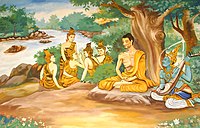 Gautama Buddha undertaking extreme ascetic practices before his enlightenment on the bank of river Falgu in Bodh Gaya, Bihar, India. |  Detail of a leaf with, The Birth of Mahavira (the 24th Jain Tirthankara), from the Kalpa Sutra, c.1375-1400. |
 Adi Shankara, an Indian philosopher who consolidated the doctrine of Advaita Vedanta by using the Upanishads for reference. |

Nalanda University is considered "one of the first great universities in recorded history."
Hindu rituals at that time were complicated and conducted by the priestly class. It is thought that the Upanishads, late Vedic texts dealing mainly with incipient philosophy, were composed in the later Vedic Age and early in this period of the Mahajanapadas (from about 600 - 400 BCE). Upanishads had a substantial effect on Indian philosophy, and were contemporary to the development of Buddhism and Jainism, indicating a golden age of thought in this period. It is believed that in 537 BCE, that Siddhartha Gautama attained the state of "enlightenment", and became known as the 'Buddha' - the elightened one. Around the same time, Mahavira (the 24th Jain Tirthankara according to Jains) propagated a similar theology, that was to later become Jainism.However, Jain orthodoxy believes it predates all known time. The Vedas are believed to have documented a few Jain Tirthankars, and an ascetic order similar to the sramana movement.The Buddha's teachings and Jainism had doctrines inclined toward asceticism, and were preached in Prakrit, which helped them gain acceptance amongst the masses. They have profoundly influenced practices that Hinduism and Indian spiritual orders are associated with namely, vegetarianism, prohibition of animal slaughter and ahimsa (non-violence).
While the geographic impact of Jainism was limited to India, Buddhist nuns and monks eventually spread the teachings of Buddha to Central Asia, East Asia, Tibet, Sri Lanka and South East Asia.
Persian and Greek invasions
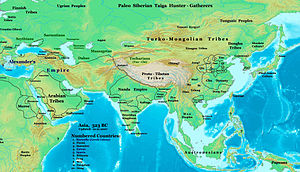
Asia in 323BC, the Nanda Empire and Gangaridai Empire in relation to Alexander's Empire and neighbors.
Much of the northwestern Indian Subcontinent (present day Eastern Afghanistan and Pakistan) came under the rule of the Persian Achaemenid Empire in c. 520 BCE during the reign of Darius the Great, and remained so for two centuries thereafter.In 326 BCE, Alexander the Great conquered Asia Minor and the Achaemenid Empire, reaching the north-west frontiers of the Indian subcontinent. There, he defeated King Puru in the Battle of the Hydaspes (near modern-day Jhelum, Pakistan) and conquered much of the Punjab.] Alexander's march East put him in confrontation with the Nanda Empire of Magadha and Gangaridai Empire of Bengal. His army, exhausted and frightened by the prospect of facing larger Indian armies at the Ganges River, mutinied at the Hyphasis (modern Beas) and refused to march further East. Alexander, after the meeting with his officer, Coenus, was convinced that it was better to return.
The Persian and Greek invasions had important repercussions on Indian civilization. The political systems of the Persians was to influence future forms of governance on the subcontinent, including the administration of the Mauryan dynasty. In addition, the region of Gandhara, or present-day eastern Afghanistan and north-west Pakistan, became a melting pot of Indian, Persian, Central Asian and Greek cultures and gave rise to a hybrid culture, Greco-Buddhism, which lasted until the 5th century CE and influenced the artistic development of Mahayana Buddhism.
Maurya Period

Maurya Empire under Ashoka the Great
The Maurya Empire (322–185 B.C), ruled by the Mauryan dynasty, was geographically extensive, powerful, and a political military empire in ancient India. The great Maurya empire was established by Chandragupta Maurya and this empire was flourished by Ashoka the Great. At its greatest extent, the Empire stretched to the north along the natural boundaries of the Himalayas, and to the east stretching into what is now Assam. To the west, it reached beyond modern Pakistan, annexing Balochistan and much of what is now Afghanistan, including the modern Herat and Kandahar provinces. The Empire was expanded into India's central and southern regions by the emperors Chandragupta and Bindusara, but it excluded a big portion of unexplored tribal and forested regions near Kalinga which was won by Ashoka the Great.
Early Middle Kingdoms — The Golden Age
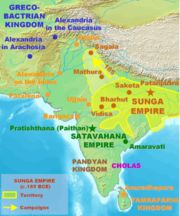 Ancient India during the rise of Sunga Empire and Satavahana Empire. | 
Kushan Empire of Ancient India.
|
 Chola Empire under Rajendra Chola c. 1030 C.E. |  Badami Chalukya Empire |
The middle period was a time of notable cultural development. The Satavahanas, also known as the Andhras, was a dynasty which ruled in Southern and Central India starting from around 230 BCE. Satakarni, the sixth ruler of the Satvahana dynasty, defeated the Sunga dynasty of North India. Gautamiputra Satakarni was another notable ruler of the dynasty. Kuninda Kingdom was a small Himalayan state that survived from around the 2nd century BCE to roughly the 3rd century CE. The Kushanas invaded north-western India about the middle of the 1st century CE, from Central Asia, and founded an empire that eventually stretched from Peshawar to the middle Ganges and, perhaps, as far as the Bay of Bengal. It also included ancient Bactria (in the north of modern Afghanistan) and southern Tajikistan. The Western Satraps (35-405 CE) were Saka rulers of the western and central part of India. They were the successors of the Indo-Scythians (see below) and contemporaneous with the Kushans who ruled the northern part of the Indian subcontinent, and the Satavahana (Andhra) who ruled in Central India.
Different empires such as the Pandyan Kingdom, Chola Dynasty, Chera Dynasty, Kadamba Dynasty, Western Ganga Dynasty, Pallavas and Chalukya Dynasty dominated the southern part of the Indian peninsula, at different periods of time. Several southern kingdoms formed overseas empires that stretched across South East Asia. The kingdoms warred with each other and Deccan states, for domination of the south. Kalabhras, a Buddhist kingdom, briefly interrupted the usual domination of the Cholas, Cheras and Pandyas in the South.
Northwestern hybrid cultures

The founder of the Indo-Greek Kingdom, Demetrius I "the Invincible" (205–171 BCE).
The north-western hybrid cultures of the subcontinent included the Indo-Greeks, the Indo-Scythians, the Indo-Parthians, and the Indo-Sassinids. The first of these, the Indo-Greek Kingdom, founded when the Greco-Bactrian king Demetrius invaded the region in 180 BCE, extended over various parts of present-day Afghanistan and Pakistan. Lasting for almost two centuries, it was ruled by a succession of more than 30 Greek kings, who were often in conflict with each other. The Indo-Scythians was a branch of the Indo-European Sakas (Scythians), who migrated from southern Siberia first into Bactria, subsequently into Sogdiana, Kashmir, Arachosia, Gandhara and finally into India; their kingdom lasted from the middle of the 2nd century BCE to the 1st century BCE. Yet another kingdom, the Indo-Parthians (also known as Pahlavas) came to control most of present-day Afghanistan and northern Pakistan, after fighting many local rulers such as the Kushan ruler Kujula Kadphises, in the Gandhara region. The Sassanid empire of Persia, who were contemporaries of the Guptas, expanded into the region of present-day Pakistan, where the mingling of Indian and Persian cultures gave birth to the Indo-Sassanid culture.
Roman trade with India

Coin of the Roman emperor Augustus found at the Pudukottai, South India.
Roman trade with India started around 1 CE following the reign of Augustus and his conquest of Egypt, theretofore India's biggest trade partner in the West.
The trade started by Eudoxus of Cyzicus in 130 BCE kept increasing, and according to Strabo (II.5.12.), by the time of Augustus up to 120 ships were setting sail every year from Myos Hormos to India. So much gold was used for this trade, and apparently recycled by the Kushans for their own coinage, that Pliny (NH VI.101) complained about the drain of specie to India:
Gupta Dynasty
 The Gupta Empire |  Kalidasa's Sanskrit play Abhijñānaśākuntala is one of the Legacy of the Gupta Empire. |
In the 4th and 5th centuries, the Gupta Dynasty unified northern India. During this period, known as India's Golden Age of Hindu renaissance, Hindu culture, science and political administration reached new heights. Chandragupta I, Samudragupta, and Chandragupta II were the most notable rulers of the Gupta dynasty. The earliest available Puranas are also thought to have been written around this period. The empire came to an end with the attack of the Huns from central Asia. After the collapse of the Gupta Empire in the 6th century, India was again ruled by numerous regional kingdoms. A minor line of the Gupta clan continued to rule Magadha after the disintegration of the empire. These Guptas were ultimately ousted by the Vardhana king Harsha, who established an empire in the first half of the seventh century.
The White Huns, who seem to have been part of the Hephthalite group, established themselves in Afghanistan by the first half of the fifth century, with their capital at Bamiyan. They were responsible for the downfall of the Gupta dynasty, and thus brought an end to what historians consider a golden age in northern India. Nevertheless, much of the Deccan and southern India were largely unaffected by this state of flux in the north.
Late Middle Kingdoms — The Classical Age
 |  | |
Pala Empire under Dharmapala
|
Pala Empire under Devapala
|
The classical age in India began with the Guptas and the resurgence of the north during Harsha's conquests around the 7th century, and ended with the fall of the Vijayanagar Empire in the South, due to pressure from the invaders to the north in the 13th century. This period produced some of India's finest art, considered the epitome of classical development, and the development of the main spiritual and philosophical systems which continued to be in Hinduism, Buddhism and Jainism.
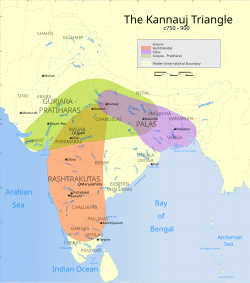
The Kanauj Triangle was the focal point of empires - the Rashtrakutas of Deccan, the Pratiharas of Malwa, and the Palas of Bengal.
King Harsha of Kannauj succeeded in reuniting northern India during his reign in the 7th century, after the collapse of the Gupta dynasty. His kingdom collapsed after his death. From the 7th to the 9th century, three dynasties contested for control of northern India: the Pratiharas of Malwa and later Kannauj, the Palas of Bengal, and the Rashtrakutas of Deccan. The Sena dynasty would later assume control of the Pala kingdom, and the Pratiharas fragmented into various states. These were the first of the Rajputs, a series of kingdoms which managed to survive in some form for almost a millennium until Indian independence from the British. The first recorded Rajput kingdoms emerged in Rajasthan in the 6th century, and small Rajput dynasties later ruled much of northern India. One Rajput of the Chauhan clan, Prithvi Raj Chauhan, was known for bloody conflicts against the encroaching Islamic Sultanates. The Shahi dynasty ruled portions of eastern Afghanistan, northern Pakistan, and Kashmir from the mid-seventh century to the early eleventh century. Whilst the northern concept of a pan-Indian empire had collapsed at the end of Harsha's empire, the ideal instead shifted to the south. The Chalukya Empire ruled parts of southern and central India from 550 to 750 from Badami, Karnataka and again from 970 to 1190 from Kalyani, Karnataka. The Pallavas of Kanchi were their contemporaries further to the south. With the decline of the Chalukya empire, their feudatories, Hoysalas of Halebidu, Kakatiya of Warangal, Seuna Yadavas of Devagiri and a southern branch of the Kalachuri divided the vast Chalukya empire amongst themselves around the middle of 12th century. Later during the middle period, the Chola kingdom emerged in northern Tamil Nadu, and the Chera kingdom in Kerala. By 1343, all these kingdoms had ceased to exist giving rise to the Vijayanagar empire. Southern Indian kingdoms of the time expanded their influence as far as Indonesia, controlling vast overseas empires in Southeast Asia. The ports of South India were involved in the Indian Ocean trade, chiefly involving spices, with the Roman Empire to the west and Southeast Asia to the east. Literature in local vernaculars and spectacular architecture flourished till about the beginning of the 14th century when southern expeditions of the sultan of Delhi took their toll on these kingdoms. The Hindu Vijayanagar dynasty came into conflict with Islamic rule (the Bahmani Kingdom) and the clashing of the two systems, caused a mingling of the indigenous and foreign culture that left lasting cultural influences on each other. The Vijaynagar Empire eventually declined due to pressure from the first Delhi Sultanates who had managed to establish themselves in the north, centered around the city of Delhi by that time.
More than 55% of the epigraphical inscriptions, about 55,000, found by the Archaeological Survey of India in India are in Tamil language and 60% from Tamil Nadu alone
The Islamic Sultanates
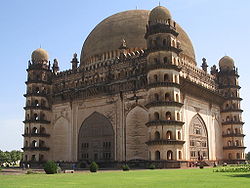
Gol Gumbaz at Bijapur, has the second largest pre-modern dome in the world after the Byzantine Hagia Sophia.
Delhi Sultanate
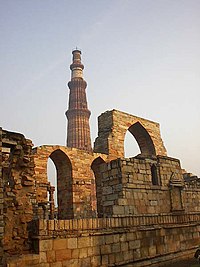
Qutub Minar is the world's tallest brick minaret, commenced by Qutb-ud-din Aybak of the Slave dynasty.
In the 12th and 13th centuries, Turkics and Pashtuns invaded parts of northern India and established the Delhi Sultanate at the beginning of the 13th century, in the former Rajput holdings.The subsequent Slave dynasty of Delhi managed to conquer large areas of northern India, approximate to the ancient extent of the Guptas, while the Khilji Empire was also able to conquer most of central India, but were ultimately unsuccessful in conquering and uniting most of the subcontinent. The Sultanate ushered in a period of Indian cultural renaissance. The resulting "Indo-Muslim" fusion of cultures left lasting syncretic monuments in architecture, music, literature, religion, and clothing. It is surmised that the language of Urdu (literally meaning "horde" or "camp" in various Turkic dialects) was born during the Delhi Sultanate period as a result of the inter-mingling of the local speakers of Sanskritic prakrits with the Persian, Turkic and Arabic speaking immigrants under the Muslim rulers. The Delhi Sultanate is the only Indo-Islamic empire to stake a claim to enthroning one of the few female rulers in India, Razia Sultan (1236-1240).
A Turco-Mongol conqueror Timur began a trek starting in 1398 to invade the reigning Sultan Nasir-u Din Mehmud of the Tughlaq Dynasty in the north Indian city of Delhi.The Sultan's army was defeated on December 17, 1398. Timur entered Delhi and the city was sacked, destroyed, and left in ruins.
The Mughal era
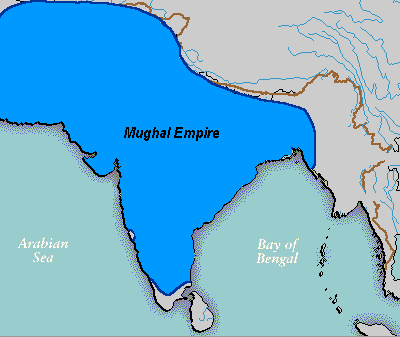

Approximate extent of the Mughal Empire in the 17th century.
Taj Mahal, built by the Mughals
In 1526, Babur, a Timurid descendant of Timur and Genghis Khan, swept across the Khyber Pass and established the Mughal Empire, which lasted for over 200 years.The Mughal Dynasty ruled most of the Indian subcontinent by 1600; it went into a slow decline after 1707 and was finally defeated during the 1857 War of Independence also called the Indian Rebellion of 1857. This period marked vast social change in the subcontinent as the Hindu majority were ruled over by the Mughal emperors, most of them showed religious tolerance, liberally patronising Hindu culture. The famous emperor Akbar, who was the grandson of Babar, tried to establish a good relationship with the Hindus. However, later emperors such as Aurangazeb tried to establish complete Muslim dominance and as a result several historical temples were destroyed during this period and taxes imposed on non-Muslims. During the decline of the Mughal Empire, which at its peak occupied an area similar to the ancient Maurya Empire, several smaller empires rose to fill the power vacuum or themselves were contributing factors to the decline. The Mughals were perhaps the richest single dynasty to have ever existed. In 1739, Nader Shah defeated the Mughal army at the huge Battle of Karnal. After this victory, Nader captured and sacked Delhi, carrying away many treasures, including the Peacock Throne.
During the Mughal era, the dominant political forces consisted of the Mughal Empire and its tributaries and, later on, the rising successor states - including the Maratha confederacy - who fought an increasingly weak and disfavoured Mughal dynasty. The Mughals, while often employing brutal tactics to subjugate their empire, had a policy of integration with Indian culture, which is what made them successful where the short-lived Sultanates of Delhi had failed. Akbar the Great was particularly famed for this. Akbar declared "Amari" or non-killing of animals in the holy days of Jainism. He rolled back the Jazia Tax for non-Muslims. The Mughal Emperors married local royalty, allied themselves with local Maharajas, and attempted to fuse their Turko-Persian culture with ancient Indian styles, creating unique Indo-Saracenic architecture. It was the erosion of this tradition coupled with increased brutality and centralization that played a large part in their downfall after Aurangzeb, who unlike previous emperors, imposed relatively non-pluralistic policies on the general population, that often inflamed the majority Hindu population.
Post-Mughal Regional Kingdoms
The Maratha Empire in 1760. The last Hindu empire of India.
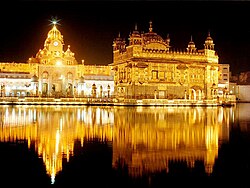
Harmandir Sahib or The Golden Temple is culturally the most significant place of worship for the Sikhs.
The post-Mughal era was dominated by the rise of the Maratha suzerianity as other small regional states (mostly post-Mughal tributary states) emerged, and also by the increasing activities of European powers (see colonial era below). The Maratha Kingdom was founded and consolidated by Shivaji. By the 18th century, it had transformed itself into the Maratha Empire under the rule of the Peshwas. By 1760, the Empire had stretched across practically the entire subcontinent. This expansion was brought to an end by the defeat of the Marathas by an Afghan army led by Ahmad Shah Abdali at the Third Battle of Panipat (1761). The last Peshwa, Baji Rao II, was defeated by the British in the Third Anglo-Maratha War.
Mysore was a kingdom of southern India, which was founded around 1400 CE by the Wodeyar dynasty. The rule of the Wodeyars was interrupted by Hyder Ali and his son Tippu Sultan. Under their rule Mysore fought a series of wars sometimes against the combined forces of the British and Marathas, but mostly against the British with some aid or promise of aid from the French. Hyderabad was founded by the Qutb Shahi dynasty of Golconda in 1591. Following a brief Mughal rule, Asif Jah, a Mughal official, seized control of Hyderabad declaring himself Nizam-al-Mulk of Hyderabad in 1724. It was ruled by a hereditary Nizam from 1724 until 1948. Both Mysore and Hyderabad became princely states in British India.
The Punjabi kingdom, ruled by members of the Sikh religion, was a political entity that governed the region of modern day Punjab. This was among the last areas of the subcontinent to be conquered by the British. The Anglo-Sikh wars marked the downfall of the Sikh Empire. Around the 18th century modern Nepal was formed by Gorkha rulers, and the Shahs and the Ranas very strictly maintained their national identity and integrity.
Colonial era
Vasco da Gama's maritime success to discover for Europeans a new sea route to India in 1498 paved the way for direct Indo-European commerce.The Portuguese soon set up trading-posts in Goa, Daman, Diu and Bombay. The next to arrive were the Dutch, the British—who set up a trading-post in the west-coast port of Surat in 1619—and the French. The internal conflicts among Indian Kingdoms gave opportunities to the European traders to gradually establish political influence and appropriate lands. Although these continental European powers were to control various regions of southern and eastern India during the ensuing century, they would eventually lose all their territories in India to the British islanders, with the exception of the French outposts of Pondicherry and Chandernagore, the Dutch port of Travancore, and the Portuguese colonies of Goa, Daman, and Diu.
The British Raj

The British East India Company had been given permission by the Mughal emperor Jahangir in 1617 to trade in India.Gradually their increasing influence led the de-jure Mughal emperor Farrukh Siyar to grant them dastaks or permits for duty free trade in Bengal in 1717.The Nawab of Bengal Siraj Ud Daulah, the de facto ruler of the Bengal province, opposed British attempts to use these permits. This led to the Battle of Plassey in 1757, in which the 'army' of East India Company, led by Robert Clive, defeated the Nawab's forces. This was the first political foothold with territorial implications that the British acquired in India. Clive was appointed by the Company as its first 'Governor of Bengal' in 1757.After the Battle of Buxar in 1764, the Company acquired the civil rights of administration in Bengal from the Mughal Emperor Shah Alam II; it marked the beginning of its formal rule, which was to engulf eventually most of India and extinguish the Moghul rule and dynasty itself in a century. The East India Company monopolized the trade of Bengal. They introduced a land taxation system called the Permanent Settlement which introduced a feudal like structure (See Zamindar) in Bengal. By the 1850s, the East India Company controlled most of the Indian sub-continent, which included present-day Pakistan and Bangladesh. Their policy was sometimes summed up as Divide and Rule, taking advantage of the enmity festering between various princely states and social and religious groups. During the British Raj, famines in India, often attributed to failed government policies, were some of the worst ever recorded, including the Great Famine of 1876–78, in which 6.1 million to 10.3 million people died and the Indian famine of 1899–1900, in which 1.25 to 10 million people died.The Third Plague Pandemic started in China in the middle of the 19th century, spreading plague to all inhabited continents and killing 10 million people in India alone. Despite persistent diseases and famines, the population of the Indian subcontinent, which stood at about 125 million in 1750, had reached 389 million by 1941.
The first major movement against the British Company's high handed rule resulted in the Indian Rebellion of 1857, also known as the "Indian Mutiny" or "Sepoy Mutiny" or the "First War of Independence". After a year of turmoil, and reinforcement of the East India Company's troops with British soldiers, the British overcame the rebellion. The nominal leader of the uprising, the last Mughal emperor Bahadur Shah Zafar, was exiled to Burma, his children were beheaded and the Moghul line abolished. In the aftermath all power was transferred from the East India Company to the British Crown, which began to administer most of India as a colony; the Company's lands were controlled directly and the rest through the rulers of what it called the Princely states. There were 565 princely states when the Indian subcontinent became independent from Britain in August 1947.
The Indian Independence movement
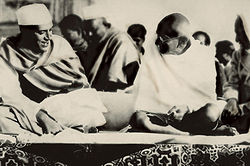
Mahatma Gandhi and Jawaharlal Nehru in 1937.

Rabindranath Tagore is Asia's first Nobel laureate and composer of India's national anthem.
The first step toward Indian independence and western-style democracy was taken with the appointment of Indian councilors to advise the British viceroy,and with the establishment of provincial Councils with Indian members the councillors' participation was subsequently widened in legislative councils.From 1920 leaders such as Mohandas Karamchand Gandhi began mass movements to campaign against the British Raj. Subash Chandara Bose was another freedom fighter who formed army forces against British rule. Bhagat Singh was also an Indian freedom fighter, considered to be one of the most influential revolutionaries of the Indian independence movement. He is often referred to as Shaheed Bhagat Singh (the word shaheed means "martyr"). Veerapandiya Kattabomman was also another freedom fighter who started his freedom movement against British rule by refusing to pay tax to British Government. Revolutionary activities against the British rule also took place throughout the Indian sub-continent, and these movements succeeded in bringing Independence to the Indian sub-continent in 1947. One year later, Gandhi was assassinated. However, he did live long enough to free his homeland.
Independence and Partition
Along with the desire for independence, tensions between Hindus and Muslims had also been developing over the years. The Muslims had always been a minority, and the prospect of an exclusively Hindu government made them wary of independence; they were as inclined to mistrust Hindu rule as they were to resist the Raj. In 1915, Mohandas Karamchand Gandhi came onto the scene, calling for unity between the two groups in an astonishing display of leadership that would eventually lead the country to independence. The profound impact Gandhi had on India and his ability to gain independence through a totally non-violent mass movement made him one of the most remarkable leaders the world has ever known. He led by example, wearing homespun clothes to weaken the British textile industry and orchestrating a march to the sea, where demonstrators proceeded to make their own salt in protest against the British monopoly. Indians gave him the name Mahatma, or Great Soul, first suggested by the Bengali poet Rabindranath Tagore. The British promised that they would leave India by 1947.
British Indian territories gained independence in 1947, after being partitioned into the Union of India and Dominion of Pakistan. Following the division of pre-partition Punjab and Bengal provinces, rioting broke out between Sikhs, Hindus and Muslims in several parts of India, including Punjab, Bengal and Delhi, leaving some 500,000 dead.Also, this period saw one of the largest mass migrations ever recorded in modern history, with a total of 12 million Hindus, Sikhs and Muslims moving between the newly created nations of India and Pakistan.
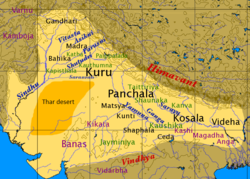


1 Comment:
Nice article.
Keep posting more devotional articles on Sanatana Dharma.
Post a Comment